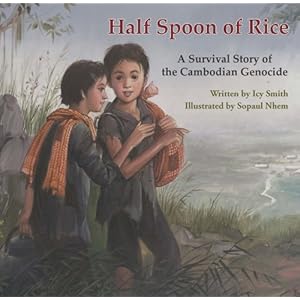Half Spoon of Rice: A Survival Story of the Cambodian Genocide
by Icy Smith
illustrated by Sopaul Nhem
44 pages
©2010
Manhattan Beach, CA: East West Discovery Press
ISBN 9780982167588
Annotation
A young Cambodian narrator describes his family's forced march and internment in a Khmer Rouge labor camp. Includes Author's Note with more detailed history of the regime.
Commentary
9-year-old Nat's tale takes readers from the rush of people leaving his home city of Phnom Penh under the direction of armed soldiers and the brutal conditions of the labor camp where Nat spends 4 years starving and scared to his escape to Thailand where he is reunited with his parents and eventually emigrates to the United States with an adopted sister orphaned by war. Though written simply, occasional phrases -- especially about hunger -- stand out as signifiers of greater horror: "Since we aren't allowed to stop and cook, we just suck on some dry grains of rice until they get chewy." "The more rice we grow, the less food we seem to get." "I find a frog and pull its legs off and eat them."
The text has a flat affect reminiscent of trauma survivors; we learn about terrible violence in short sentences like "One child who cries a lot also does not come back." and "A few who didn't keep moving as they were told lie dead by the side of the road." Unlike other first-person narratives for children, this story states facts rather than describing how the characters feel from the inside perspective: "I have been so scared and hungry." "I am so sad for them." "This is the most terrible thing that has ever happened to us." The story touches on this inability -- "Everybody looks dazed. We cannot express our feelings." It's the job of the illustrator to carry the balance of the storytelling burden. Though occasionally Nhem's pictures don't quite match the text, they express a wealth of emotion in the characters' faces. Details in the background include people marching with crutches, a friendly doctor in a refugee camp, a watchtower where men with guns keep an eye on the field laborers. In many of the illustrations, long lines of people make an appearance: a symbol perhaps of the many victims of genocide and the survivors of the war... a list that includes Nhem's own father, who advised his son on the historical accuracy of the paintings.
Students may be shocked by the realities of the Cambodian civilians during the "secret war". As the author writes in her historical notes following the story, "The country of Cambodia became akin to a gigantic prison farm." Students will draw comparisons with WWII concentration camps in Europe (and possibly the Japanese-American internment camps), even if they weren't aware of the Asian conflicts of the Vietnam War. This book could be used in an 10th-grade history class (Ours was 20th-Century World History) to present an additional viewpoint along with the standard focus on U.S. forces.
No Author Info
No Illustrator Info
Media: oil paint

No comments:
Post a Comment
Please be civil to other commenters.